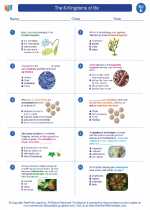Glands
Glands are organs in the body that secrete substances such as hormones, sweat, or saliva. They play a crucial role in maintaining homeostasis and regulating various bodily functions.
Types of Glands
- Exocrine Glands: These glands secrete their products into ducts, which then carry the secretions to the body's surface or into body cavities. Examples include sweat glands and salivary glands.
- Endocrine Glands: Endocrine glands secrete hormones directly into the bloodstream, where they are carried to target organs or tissues. The pituitary gland, thyroid gland, and adrenal glands are examples of endocrine glands.
- Apocrine Glands: These glands are a type of exocrine gland that release a portion of the cell with the secretion. They are found in the breasts, ear canal, and eyelids.
- Holocrine Glands: Holocrine glands release entire cells filled with the secretory product. The sebaceous glands in the skin are an example of holocrine glands.
Functions of Glands
Glands perform various functions in the body, including:
- Regulating metabolism and growth
- Maintaining fluid and electrolyte balance
- Controlling reproductive processes
- Assisting in digestion
- Regulating body temperature
Study Guide
When studying glands, it's important to understand the different types of glands, their functions, and the role they play in maintaining overall health. Here are some key points to focus on:
- Identify and differentiate between exocrine and endocrine glands.
- Understand the specific functions of major endocrine glands such as the pituitary, thyroid, and adrenal glands.
- Explore the role of glands in maintaining homeostasis and regulating bodily functions.
- Discuss the impact of glandular disorders on overall health and well-being.
Additionally, it can be helpful to study specific examples of glands and their secretions, and to understand how they interact with other systems in the body.
Remember to review diagrams or illustrations showing the location and structure of various glands to enhance your understanding of their anatomy.
.◂Science Worksheets and Study Guides Fifth Grade. The 6-Kingdoms of life
Study Guide The 6-Kingdoms of life
The 6-Kingdoms of life  Activity Lesson
Activity Lesson Kingdoms
Kingdoms  Worksheet/Answer key
Worksheet/Answer key The 6-Kingdoms of life
The 6-Kingdoms of life  Worksheet/Answer key
Worksheet/Answer key The 6-Kingdoms of life
The 6-Kingdoms of life  Worksheet/Answer key
Worksheet/Answer key The 6-Kingdoms of life
The 6-Kingdoms of life  Worksheet/Answer key
Worksheet/Answer key The 6-Kingdoms of life
The 6-Kingdoms of life  Vocabulary/Answer key
Vocabulary/Answer key The 6-Kingdoms of life
The 6-Kingdoms of life  Vocabulary/Answer key
Vocabulary/Answer key The 6-Kingdoms of life
The 6-Kingdoms of life  Vocabulary/Answer key
Vocabulary/Answer key The 6-Kingdoms of life
The 6-Kingdoms of life  Vocabulary/Answer key
Vocabulary/Answer key The 6-Kingdoms of life
The 6-Kingdoms of life 

 Activity Lesson
Activity Lesson
 Worksheet/Answer key
Worksheet/Answer key
 Worksheet/Answer key
Worksheet/Answer key
 Worksheet/Answer key
Worksheet/Answer key
 Worksheet/Answer key
Worksheet/Answer key
 Vocabulary/Answer key
Vocabulary/Answer key
 Vocabulary/Answer key
Vocabulary/Answer key
 Vocabulary/Answer key
Vocabulary/Answer key
 Vocabulary/Answer key
Vocabulary/Answer key

The resources above cover the following skills:
Concepts of Life Science (SC1, SC2, SC3)
The student demonstrates an understanding of the structure, function, behavior, development, life cycles, and diversity of living organisms by identifying and sorting animals into groups using basic external and internal features.